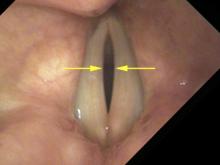If the vocal cord muscles are not exercised regularly by talking (imagine a lighthouse keeper sitting alone on an island year after year), the vocal cord muscles atrophy and can no longer tense to a straight line. They remain concave, even when the back of the cords are completely closed. Consequently, a central gap is created.
Aging contributes to this as well. Much like the skin on the face gradually sags with aging, the vocal cords sag with aging as they lose elasticity. Typically this sagging, or as physicians call it, bowing, is relatively symmetric. There is a nearly oval shaped gap with pointed ends between the vocal cords. Air leaks out the middle.
At the beginning of sound production, the back of the vocal cords have touched, but the arrows point to a large central gap.

